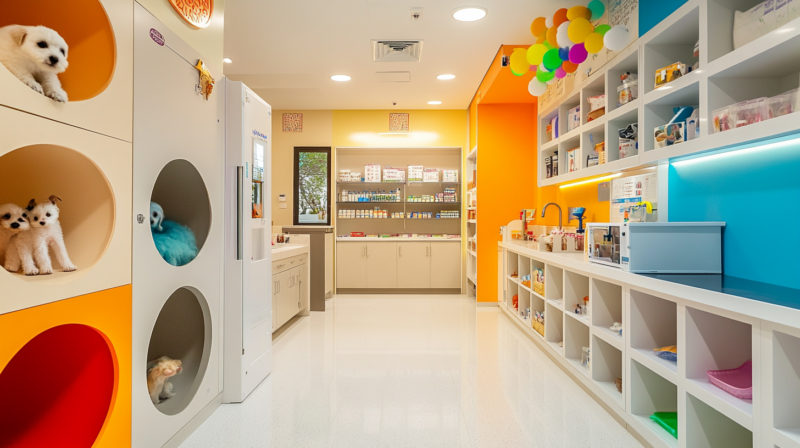In this article:
In veterinary care, customer trust is essential. After all, not only are more and more people owning pets, but many also care deeply about their furry friends, as 97% of pet owners see their pets as family.
The color and design of your veterinary clinic plays a key role in shaping customers’ perception. Below, we’ll explain how you can use these elements wisely to become the go-to vet in town!
Choosing the Right Colors: Color Psychology and Branding
Studies have shown that different colors evoke different emotions. Advertisers have used this knowledge, choosing colors that fit their product and brand image the most.
As a business, you should definitely be doing the same. Ask yourself – do you want your clinic to seem…
- …tranquil?
- …warm?
- …professional?
- …a mix of these?
Based on this, choose which colors to use for both your advertising materials as well as your physical establishment.
Cool colors: blues and greens
Softer shades of blue and green are often associated with nature, reminding us of trees and bodies of water. They evoke feelings of calmness, serenity, and healing.
These colors are relaxing, reducing anxiety and helping pet owners feel reassured. In a way, it essentially sends the message: Don’t worry, we’ll heal your sick pet.

Get 300+ Fonts for FREE
Enter your email to download our 100% free "Font Lover's Bundle". For commercial & personal use. No royalties. No fees. No attribution. 100% free to use anywhere.
Warm colors: yellows and oranges
Meanwhile, colors like yellows or oranges are more upbeat, creating an atmosphere of warmth, friendliness, and joy. It creates a welcoming space that encourages communication, making initial interactions between staff and pet owners more cordial.
Choose this color palette if you want people to associate your clinic with having a fun, casual atmosphere. For example, this can work if your clinic is located in a smaller town.
Neutral tones: beige, light grays, and soft whites
Like hospitals, veterinary clinics can also use neutral colors to create a clean and professional environment. You’ll emphasize your clinic’s competence—that you are serious about delivering expert patient care.
However, starker whites may seem too sterile or intimidating. It’s often better to mix them with grays, beiges, or stick to more cream-like shades of white.
It’s also a good idea to use these neutral colors as a backdrop to the cooler or warmer colors! Doing this exhibits both medical professionalism and warmth.
Ergonomic Design
Beyond color, the physical design and layout of a veterinary clinic are also important.
Pet-friendly environments
As a vet clinic, you should cater to the comfort of both people and their animals.
Since animals often feel stressed or act aggressively around other animals, ensure to have a wide enough space for pet owners to sit far enough from each other. You should likely also have a separate space for dogs and cats.
The walls of the room must also be softly lit and have natural textures to create a more relaxing atmosphere. Ideally, they should also be soundproof, to minimize noise distractions (those barks can get loud, after all!)
Lastly, it’s a good idea to have soft and non-slip flooring to cater to the paws of pets.
Intuitive layouts
The layout of your clinic should be intuitive and conducive for efficient service delivery. Clear signages, well-organized rooms, and navigable corridors will minimize confusion and help clients feel more at ease.
Comfortable waiting areas
First impressions last. And the waiting room, as your client’s first point of contact with the clinic, must be comfortable and welcoming. Pets can get messy, so be sure to clean it often throughout the day.
Place comfortable seating, an accessible reception desk, and have strategically placed information materials as well. If you can, try to offer treats and water too—for both humans and animals.
Other Ways to Build Trust:
As a bonus, here are a few other ways you can build trust:
- Ask for feedback
Asking for feedback can show that you truly care about your customer’s experience and are dedicated to improving. - Protect client data
Medical records involve highly personal information. Ensure clients that you protect their data so that it remains confidential by employing data security measures, such as using secure storage applications, using VPN for IP address masking, and diligently organizing data. - Build long term relationships
The longer you know someone, the more you trust them. Establish rapport and build relationships with your clients by getting to know them and their pets, offering preventive care packages, and providing regular veterinary education.
Conclusion
Aesthetics isn’t just about looking good—it can also convey meaning. Through thoughtful color and design choices, you can build a trustworthy brand image that will attract pet owners—and keep them coming back as loyal patrons of your practice.

